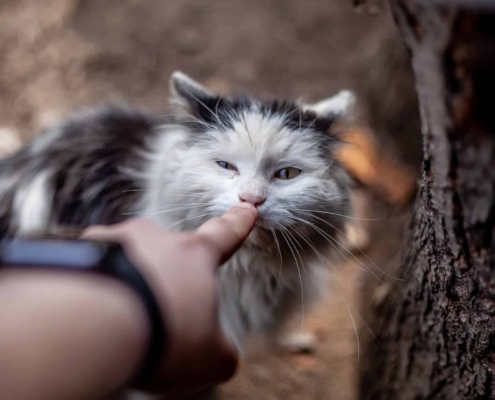
Cats are wonderful companions, but dealing with their litter boxes can be a hassle. The idea of toilet training your cat might sound like a dream come true – no more scooping, no more litter mess, and no more unpleasant odors. But can cats really be trained to use the toilet like humans? In this article, we will explore whether toilet training is possible for cats, the pros and cons of this approach, and provide you with a step-by-step guide to get started.
Is it Possible to Train Cats to Use the Toilet?
Yes, it is possible to train cats to use the toilet, but it requires patience, consistency, and a gradual approach. Cats are naturally clean animals, and they have the ability to learn new behaviors. However, it is important to note that not all cats will take to toilet training, and some may prefer using a litter box. It is essential to understand your cat’s personality and preferences before embarking on the toilet training journey.
Pros and Cons of Toilet Training Cats
Toilet training cats offers several advantages. Firstly, it eliminates the need for a litter box, saving you time and money spent on litter and cleaning supplies. Secondly, it reduces the risk of litter-related health issues, such as respiratory problems caused by dust particles. Additionally, toilet-trained cats eliminate their waste directly into the toilet, preventing unpleasant odors in your home. However, there are also downsides to consider. Toilet training requires time and effort, and not all cats will successfully make the transition. Some cats may experience stress or anxiety during the training process, and accidents can happen, leading to messes and potential damage to your bathroom.
Steps to Toilet Train Your Cat
Toilet training your cat requires a gradual approach. Here are the steps to follow:
- Familiarize your cat with the bathroom: Introduce your cat to the bathroom gradually, allowing them to explore and feel comfortable in the space.
- Adjust the litter box: Move the litter box closer to the toilet, gradually raising it until it is at the same level as the toilet seat. This helps your cat associate the litter box with the toilet.
- Introduce a training seat: Replace the litter box with a training seat that fits over the toilet seat. This seat has a hole in the middle, allowing your cat to eliminate directly into the toilet.
- Gradually remove the training seat: Over time, remove the training seat, exposing more of the actual toilet seat. This helps your cat get used to the idea of eliminating directly into the toilet.
- Remove the training seat completely: Once your cat is comfortable using the toilet without the training seat, remove it entirely. Your cat should now be fully toilet trained.
Common Challenges and How to Overcome Them
Toilet training cats can come with its fair share of challenges. Here are some common issues and tips to overcome them:
- Resistance to the training seat: Some cats may be resistant to using the training seat. To encourage them, try using treats and positive reinforcement when they successfully use the seat.
- Accidents outside the toilet: Accidents can happen during the training process. If your cat eliminates outside the toilet, clean the area thoroughly and remain patient. Consider taking a step back in the training process and gradually progress again.
- Fear of falling into the toilet: Some cats may be afraid of falling into the toilet. To alleviate this fear, place a non-slip mat or towel on the toilet seat, providing a stable surface for them to stand on.
Tips for Successful Toilet Training
Here are some additional tips for successful toilet training:
- Be patient and consistent: Toilet training takes time, so be patient with your cat. Consistency is key, so follow the same routine every day.
- Use positive reinforcement: Reward your cat with treats, praise, and affection when they successfully use the toilet.
- Monitor your cat’s behavior: Pay attention to your cat’s body language and cues to anticipate when they need to use the toilet. Prompt them to the bathroom during those times.
Alternative Options for Cat Litter Boxes
If toilet training is not suitable for your cat or household, there are alternative options to traditional litter boxes. Some options include self-cleaning litter boxes, litter box furniture, and disposable litter trays. Explore these alternatives to find the best fit for you and your cat.
Real-Life Success Stories of Toilet-Trained Cats
Many cat owners have successfully toilet trained their feline friends. One such success story is that of Sarah and her cat, Whiskers. Sarah patiently followed the training steps and provided positive reinforcement. Whiskers quickly caught on and is now happily using the toilet like a pro. These success stories show that with dedication and the right approach, toilet training can be achieved.
Frequently Asked Questions About Toilet Training Cats
- Q: How long does it take to toilet train a cat?A: The duration can vary depending on the cat’s personality and willingness to learn. It can take anywhere from a few weeks to several months.
- Q: Can toilet training be done with older cats?A: Yes, toilet training is possible with older cats. However, it may take longer for them to adjust to the new routine.
- Q: Will toilet training affect my cat’s health?A: Toilet training, when done correctly, should not have any negative impact on your cat’s health. However, it is important to monitor their behavior and consult a veterinarian if you notice any unusual signs.
Is Toilet Training the Right Choice for You and Your Cat?
Toilet training cats can be a convenient and hygienic alternative to traditional litter boxes. While it requires time, patience, and effort, many cat owners have successfully trained their cats to use the toilet. Consider your cat’s personality, preferences, and your own commitment level before deciding if toilet training is the right choice for you and your furry friend. Remember, every cat is unique, and what works for one may not work for another.
If you enjoyed my article, I would appreciate you sharing it with your network.

Sima Ndlebe
Sima writes for CatBuzz. He is interested in Cats, Health and Fitness, and Entrepreneurship.
Published: 27 March 2024




